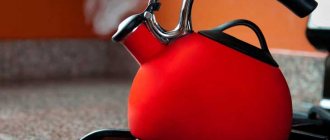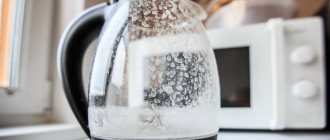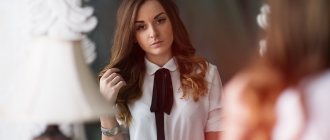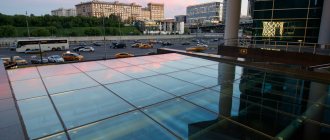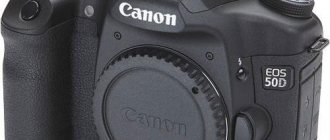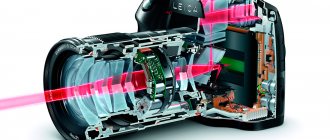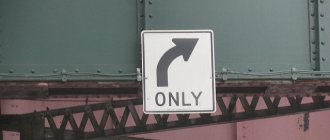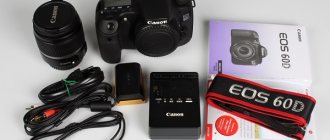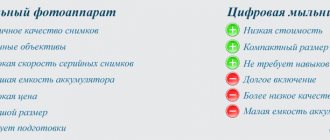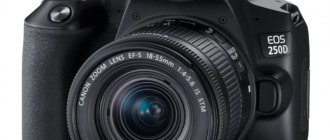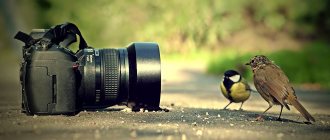Shutter speed units and terminology
Measured in seconds. Cameras display a number, for example, 50. This means the shutter speed is 1/50 s. Those. The camera shutter will open, the matrix will receive light for 1/50 s, the shutter will close and exposure will stop. If the camera displays, for example, 5”, then this means that the shutter speed = 5 s.
Distinguish between short and long exposure
Examples of fast shutter speed values: 1/1000 s, 1/2500 s (will be marked on the screen and in the camera viewfinder as 1000 and 2500, respectively). Example of a long shutter speed: 3 s (marked as 3 on the camera).
The boundaries of the classification of short and long exposures are very arbitrary, including depending on the subject. For example, when shooting a fast bird, a shutter speed of 1/500 s may turn out to be long - the bird will turn out blurry. It is important to understand the principle that terminology depends on the plot. If somewhere you come across a phrase like “make the shutter speed shorter/longer,” you’ll know what I’m talking about.
The shortest shutter speeds on modern DSLRs are 1/4000 or 1/8000 (in more advanced models). On mirrorless cameras in electronic shutter mode they can be set up to 1/32000 s. Such short shutter speeds may be necessary when shooting very fast objects or when using open apertures on high-aperture optics in bright sun. Long exposure is limited to 30 seconds, but there is a BULB mode in which the first press of the shutter button opens the shutter, and the second press closes it. To avoid movement, use remote controls. In other words, the long shutter speed is not limited in any way, and you can expose the matrix for at least hours. Such long shutter speeds are used for evening/night photography and special transmission of motion.
We haven’t looked at exposure yet, but I’ll still mention that shutter speed affects the amount of light received in direct proportion. The longer the shutter speed, the more light falls on the matrix; the shorter the shutter speed, the less light. When you increase/decrease the shutter speed by 2 times, the amount of light received increases/decreases by 2 times. For example, changing the shutter speed from 1/400 s to 1/200 s will double the amount of light received. This change is called an exposure stop. At this stage, it is important to understand that with a shorter shutter speed, the resulting photo will be darker, and with a longer shutter speed, it will be lighter.
Classification.
So, the camera shutter speed can be short or long. A short parameter is considered to be from 1/60 to 1/8000 of a second, while a long one is from 0.5 seconds to 30 seconds. The first type allows you to obtain an image almost instantly, which is beneficial for use in dynamic scenes. The second type is more convenient for obtaining a beautiful image, getting rid of unnecessary details and drawing with light.
Officially speaking, there are many meanings for shutter speed. There is a standard among camera manufacturers according to which a fraction of a second is indicated in the parameter value (for example, 1/1000), but due to inconvenient recording, the denominator is taken as an indicator and the numerator is omitted, that is, simply 1000. This designation is relevant for the parameter if it is less than a second, and if it is larger, the number of seconds is simply recorded.
However, no matter how wide the range of acceptable values covered, it was not sufficient. Therefore, we created unique modes for adjusting shutter speed.
It is not possible to activate them on every camera, but if there is an opportunity, then it can be activated by setting a special parameter on the mode selection wheel.
This is B or Bulb. It allows the shutter to remain open while the shutter button is pressed. This can be convenient for shooting “light photography”.
How to adjust shutter speed in camera?
The camera sets shutter speed in two modes: manual (M) and shutter priority (S).
In other cases, it is calculated automatically by the camera. It is displayed on the camera:
- in the viewfinder;
- on the main screen;
- on the top screen
Shutter speed 1/320 on main screen
Shutter speed 1/320 in the viewfinder
Let me remind you that an integer number will be displayed, for example: 50, 640. This means that the shutter speed is set to 1/50 or 1/640. Or, if the number is displayed with a “seconds” icon, then the number is the shutter speed in seconds.
To learn how to change the shutter speed on your camera, refer to the manual. For example, on Nikon cameras, it is changed by turning the wheel under the thumb of the right hand.
Those. set the mode to M or S and turn this wheel to change the shutter speed. In S (shutter priority) mode, the camera will select the aperture automatically. In M mode, all parameters must be set manually.
If you scroll the wheel all the way to the left, the last value will be BULB mode, in case 30 seconds is not enough.
Shutter speed and exposure
Another important effect of shutter speed is its impact on the brightness of the photo. When using a slow shutter speed, the camera sensor will collect a lot of light and the resulting image will be quite bright. When using a fast shutter speed, only a small portion of the light is exposed to the camera sensor, resulting in a darker image.
Dependence of image brightness on shutter speed
However, shutter speed is not the only variable that affects the brightness of an image. There's also aperture and light sensitivity (ISO), as well as the actual brightness of the scene in front of you. This gives you some flexibility when choosing shutter speed, but you need to choose other settings carefully as well.
Secrets of RAW.
Professional processing
Read in Litres
Read: What is a camera aperture - the basics of exposure in photography
Shutter speed can be an important tool for capturing a photo at the right brightness. On a sunny day, you may need to use a fast shutter speed to avoid overexposing your photo.
Or, if the scene is poorly lit, a slow shutter speed may be required to avoid the photo becoming too dark (which in turn may require a tripod due to the blur caused by holding the camera handheld).
For many people, this is the main reason for adjusting shutter speed: To make sure your photos are at the correct brightness. However, motion blur issues are also very important and should not be ignored.
Effects that can be achieved with exposure
It is clear that shutter speed can radically change the frame. As a result, you need to achieve an understanding of what kind of frame you want to get, whether shutter speed is important for these purposes and in such conditions. If important, then what? Over time, these questions will automatically flash through your head and your brain will produce a bunch of answer options, forming them from past experience and observation.
Let's now look at exactly what effects you can get.
Freeze motion
If the object is moving, then you can get a clear photograph using a short shutter speed, “freezing” it. The object can be anything: an athlete performing on stage, splashes of water, running animals, cars. In general, there is a lot of movement in our world) The main thing is to make sure that what you are shooting will look good in a “frozen” state.
Photo hack - no one bothers you to try several techniques when shooting the same thing, if time permits. And there will be plenty to choose from, and experience will be gained.
The dove just froze in the sky.
In this case, you can get a static photograph, which can look boring and even fall out of context. These shortcomings are offset by compositional techniques, for example, tilting the object. Or like in the example with the pigeon above - notice the feathers at the tip of the wing - they are blurred. Those. the shutter speed was slightly longer than required to completely freeze the movement. This adds a feeling of flight; the viewer understands that the dove is flying, and that this is not just a figurine.
The shutter speed must be selected depending on the speed of the object and the distance to it. We’ll talk about approximate recommended values below; you can use them as a guide. More accurately determined experimentally.
Dynamic water, for example, fountains, can look good in a “frozen” form:
Water drops can look interesting at very short shutter speeds:
The technique of freezing movement is worth keeping in mind, but I don’t recommend getting carried away with it - you can lose the atmosphere of what is happening and get only dry facts in the photo.
Motion Blur
The effect is exactly the opposite of the previous one. Our eye cannot see the result of prolonged exposure to light; it forms a picture frequently, i.e. conditionally - the shutter speed of our eyes is constant. The camera can “look” at the world with an eye wide open) In general, show us what we don’t see.
For example, above we can “see the wind” (vapor), which, when illuminated, brings zest to an ordinary cityscape. This is achieved through long exposure.
Moving clouds in the sky are a good option for blur. This way the photo can become more dramatic and voluminous.
It would seem that an ordinary static picture acquires dynamics due to slightly blurry clouds and treetops on the right. True, the wide angle, the converging perspective of the median strips on the road and twilight time contribute here.
The longer the shutter speed, the fewer small details will remain on moving objects (sky, water), all other things being equal.
Water, transport, sports, crowds of people, carousels - all are good candidates for using this technique. Try it, experiment.
Panning or panning
When using this technique, the object appears sharp , as if we are freezing it, and the background is blurred . Sufficiently long and medium shutter speeds are used. Conditional range – 1/10 – 1/200 s. The required shutter speed depends on the speed of the object and the distance to it.
The basic principle is to hold the camera tightly and very smoothly rotate it either with your hands or with your body so that the position of the object does not change in the frame. That is, if the car is in the upper left part of the frame, then when moving you need to rotate the camera so that it remains in the same upper left part. Due to the change in distance, it may change slightly in size, but there is nothing wrong with that - the shutter speed is not so long that trails will appear, and those that exist will only enhance the effect of the movement.
Cars are a classic example and an ideal target for such experiments. By the way, pay attention to advertising car brochures - very often you can see photographs with panning. The result is a very effective transfer of dynamics and the feeling that the car exists outside of time. But not just cars, you can try to photograph cyclists too)
Select the shutter speed experimentally:
- if everything turns out blurry, shorten it;
- if, on the contrary, everything is clear, lengthen it.
By the way, when selecting shutter speed, pay attention to the degree of background blur depending on the speed of the subject. Let me explain - in a frame with a bicycle (if it is assumed that this is not a flying road bike), the background should not be blurred into trash, as if the cyclist is rushing like a racing car. It will look unnatural. In the case of cars, the background may be more blurred.
Let's go back to cars again) It's very good if the background itself is beautiful and eye-catching, especially if we look at the car from an angle. And, ideally, you should not forget about the foreground - a clear division of the photograph into plans is always beneficial.
We are leaving towards the sunny horizon!)
In addition to cars, try filming running people, athletes, birds, running animals (with a predictable trajectory). But I note that this technique is not easy and requires proper skill and training. If it doesn't work out, don't be upset. The output of suitable personnel here is low. Just change the shutter speed and analyze the changes. And in the end everything will work out.
Evening and night photography
It can be nice to walk through the city at night and take pictures of this beauty. If you shoot portraits, then fast lenses with open apertures and cameras that are less noisy at high ISO will come to the rescue. The shutter speed, of course, will also have to be shortened, but to certain limits. Even if your model tries to freeze, it will still be difficult to shoot at shutter speeds shorter than 1/30 - there is a high risk of getting movement and blur.
When shooting evening landscapes, the approach is different. For a sharp photo, it is advisable to close the aperture. This means that much less light will reach the matrix. To learn about the relationship between the amount of light received and aperture values, go to the material.
Blurry landscapes are a frequent bane of photographers. If this problem occurs, be sure to look at the checklist!
Since there is less light, the mandatory attributes for evening landscape photography are long shutter speeds and a tripod. In the first example I will show water.
Blurred water and clouds
Water is generally a very multifaceted topic from a photography point of view. Long exposures can produce a calm, mirror-like surface. The camera allows us to see what we cannot see with our own eyes. The clouds are also blurred - exactly what we discussed in the motion blur effect. The principle is the same, only in view of the evening shooting we use long shutter speeds.
How long the exposure is will determine whether any detail will remain in the sky or water.
If it were not for the long exposure, even taking into account the light from the lanterns, the picture would have turned out to be severely underexposed (dark).
Another magical example of evening shooting is tracers and people. With long exposures, only those details remain that were in the same place for the maximum exposure time (light received by the matrix). For example, when shooting oncoming traffic, the main bright object is the headlights. If held for a long time, they will form tracers. If the shutter speed is not too long, then “ghosts” from car bodies will be noticeable.
The situation is similar with people - the longer a person stands still, the more clearly he will be captured. If a crowd of people moves, “ghosts” will appear. They can be barely visible at very long exposures, but at short enough we may be able to see individual people as if they were blurred. Again, this depends on the shutter speed, the speed of people moving and the intensity of the flow. Our task is to learn how to select shutter speed so that the flow is captured the way we want it.
In the example above, there are tracers from oncoming traffic on the left, and a blurry guy on the right near the bench. At the same time, the rest of the company on the bench turned out to be clear, which means the exposure was not too long.
Types of aging and their application
Now that you have memorized how to adjust shutter speed, let's look at 10 different situations in which you need to master it to get good results.
Freeze motion
There are many situations in which you will need to freeze motion. Photographing an animal running, jumping, or water drops from a fountain or waterfall are prime examples of this situation.
To do this, you need to increase the shutter speed so that the camera shoots fast enough to stop the subject from moving and prevent it from moving. Obviously, each subject will have a different shutter speed, so it's best to do some tests to determine what shutter speed is needed to stop motion.
To give you an idea, we typically use speeds like 1/1000 sec. for fast cars or running animals, 1/500 sec. for bicycles and 1/250 sec. for sea waves. However, these are indicative speeds as the speed of any of these types of photographic objects can vary greatly.
That's why the best you can do is run some tests, and if you don't have the option, it's best to use a high enough speed, even if it's too fast, so that you don't risk losing the photo. Think that it will always be better to take a well-taken photo with little noise from having to compensate for an excessive shutter speed, than to take a photo that loses the center of interest.
Long exposure
Freezing movement multiple times is not enough for us. Sometimes completely freezing motion can result in a photo that doesn't convey what we're looking for. For example, if we freeze the movement of a racing motorcycle, it will appear as if it has stopped, it will not give us a dizzying sensation of speed.
For these types of photographs, where we want a moving subject to be captured without losing the effect of speed, we usually use a slow shutter speed. Long exposure on a camera is a technique that costs a little money to get the hang of it, but once the controls are in place you see how easy it is to get good results.
To scan, you need to use a slow shutter speed and follow your subject at the same speed while the shutter is open. The subject will appear static and the background will be magnified three times, creating a sense of speed. If you prefer, you can use a tripod to follow your subject in a straight line.
How to choose shutter speed?
Choosing the appropriate shutter speed can be difficult. To begin with, I will describe the basic algorithm that you should focus on.
- Is shutter speed important in principle for the subject being filmed? Maybe at any shutter speed you will get approximately the same results, or will its incorrect value ruin the frame? If the first option is ours, then we turn our attention to other parameters. For example, on the diaphragm. Read about choosing aperture and its recommended values for specific scenes here.
- Determining how the frame should look . We build the final look of the photograph in our heads. Let's focus on the effects presented above. And, based on this, we select a suitable shutter speed from the approximate range.
- We identify problems that need to be mitigated with endurance . In some situations, by adjusting the shutter speed, we are not chasing the effect in the frame, but are leveling out the problems that arise during shooting. For example, when shooting with an open aperture using high-aperture optics in bright sunlight, you will have to set very fast shutter speeds to get the correct exposure. There is no artistic effect achieved here - you just need to get the frame with the correct exposure.
- We take sighting shots, analyze the results and change the parameters . And so iteratively in a circle until we get the desired result.
The more experience you have, the faster and easier it will be to complete step 4.
When to use what shutter speed?
For clarity, I compiled a table describing frequently encountered situations. It will help you decide when to use a long shutter speed and when to use a short shutter speed.
I note that the values I indicate are approximate. There are no dogmas here, each case is unique. Therefore, treat these numbers as basic ones, from which you can build on and select the appropriate value.
| Situations | Description and shutter speed ranges |
| Little light. | Whether it’s a dark room or twilight, we lengthen the shutter speed so as not to get blur and movement. We focus on the formula: the shutter speed should be no longer than 1/EGF. If you don't know the equivalent focal length and crop factor, here you go. If the subject is static, then we simply try to get a sharp frame without movement at a minimum ISO. In this case, we select the aperture to suit the subject. As a rule, we are talking about shutter speeds around 1/25 – 1/50. If there is movement in the frame, then we use fast optics and an open aperture, raise the ISO and select the shutter speed so that there is no blur. Don't forget about an external flash - it can help out indoors. |
| Exposure is the main remedy in the fight against smearing and movement. | Don't forget about the formula: shutter speed is shorter or equal to 1/EGF. We shorten the shutter speed if it is not possible to take a clear photo at values that are not too long (for example, 1/30). |
| Night city photography. | Depending on the illumination, the values can vary approximately as follows: 1/10 - 15 s. Be sure to use a tripod and don’t forget to turn off VR (vibration reduction function), if available. |
| Evening portraits. | At shutter speeds longer than 1/20, even with short-focus optics, it is difficult to obtain clear images. Advice: in the evening we do not use long-focus optics (105 mm or more). Even 85mm can be left at home. Try fast 50mm and 35mm lenses (with VR stabilization) and shoot more atmospheric portraits of a person in the city, rather than just a person with a blurry background. This will allow you to use longer shutter speeds. It's hard to make a person freeze anyway, so long shutter speeds won't work for us anyway. If even with an open aperture the frame turns out to be underexposed, raise the ISO. And we definitely shoot in RAW - later it will be possible to pull out the dark failed details and partially level out the noise that appeared due to the high ISO. If you have an expensive full-frame camera, then it will be much easier to shoot - you can raise the ISO too much without the risk of getting low-detail soap with poor color, shorten the shutter speed, and it’s easier to use long-focus optics. And it’s easier to draw details in RAW. In general, for such shooting, a full frame frees up your hands. |
| Long-focus optics. | Again, the rule about 1/EGF is the same. If you choose optics, give preference to stabilized options (with VR). The motor compensates for vibration, and it’s easier to shoot handheld at longer shutter speeds - there’s less risk of getting shakes. Example: you are shooting birds with optics with a 200 mm DF on a crop lens. On Nikon the EGF will be 300 mm. This means that a necessary condition for shooting is to use a shutter speed of 1/300 or faster. Please note that the condition is necessary, but may not be sufficient, because We film not static, but the movement of birds. For fast flight, 1/300 will probably not be enough - 1/800, 1/1000 or shorter is better. |
| Excess light. | We compensate with closed apertures and short shutter speeds. What if we are shooting a portrait in the desert under the scorching sun? And at the same time we want to get strong blur and open the aperture to 1.4. A? It will still be overexposed. Ultra-short shutter speeds come to the rescue - 1/2500, 1/4000 and even 1/8000 s. By the way, not all cameras support a shutter speed of 1/8000 (we are talking about a mechanical shutter). Some consider its presence a sign of professionalism of the camera. In any case, this makes it easier to work with high-aperture optics in situations like in the example. |
| Shooting with wiring. | Approximate range – 1/10 – 1/200 s. For fast moving cars and birds, try starting with the range – 1/80 – 1/160. Cyclists, other athletes – 1/40 – 1/60. If the image still comes out clear, zoom in to 1/20 - 1/40 or more extreme values. |
| Water, clouds. | For freezing, we try shutter speeds of 1/500 and shorter. Need a water flow with details? Try ¼ - 4 s. Need a blurry water stream with no details? Try > 4 s. The transmission of cloud motion is highly dependent on their speed. Movement in very strong winds will be noticeable at a shutter speed of 1/15 or 1/10. Usually, a beautiful blur is obtained at 3–15 s. If you want to get an abstract photo, where water and sky turn into a monochromatic substance without details, we try the range of 20 - 30 s and more. |
| Tracers. | You can try sighting for 10 – 30 s. If there is a large dense flow of cars, you can try for 3 – 5 minutes. If the flow is small, then the tracers will be almost invisible. |
| Sport. | The more dynamic, the shorter the shutter speed) Everything is individual, I will not give specific values. It all starts at about 1/200 and shorter. Let me draw your attention to one detail - the speed of the subject being photographed relative to the photographer changes. For a car rushing past, the shutter speed should be much shorter than for the same car that we are filming from afar, when it is moving towards us or away from us. If there is not enough light and the plot allows, you can use this fact. |
About exposure for beginners
NIKON D850 / 70-300 mm f/4.5-5.6 SETTINGS: ISO 64, F7.1, 1/50 s, 70.0 mm equiv.
Shutter speed, or the exposure time of a photo, is the time it takes the camera to take a photo. At first, everything here seems simple, but the deeper you dive into the topic, the more complex and interesting it becomes.
Exposure of a photo on a DSLR camera. The mirror rises, the shutter opens for the duration of the exposure, then closes.
In modern cameras, the exposure time is determined by the shutter. Before shooting begins, the matrix is covered with opaque curtains (lamellas), and is only opened for a short time to take a shot. The shutter is a very precise mechanism that can open for a given shutter speed with an accuracy of thousandths of a second. We have already prepared a separate lesson in more detail about the operation of the shutter.
Shutter speed is measured in seconds and, more often, in fractions of a second. Even the most affordable models of modern DSLRs and mirrorless cameras operate at shutter speeds from 1/4000 to 30 seconds.
Camera Information Display: Shutter speed set to 1/60 sec.
Camera information display: shutter speed set to 6 sec.
The current shutter speed is always displayed on the screen and in the camera viewfinder, even if you are shooting in Auto mode.
Most often, shutter speed is indicated by a fraction. The higher the number in the denominator, the shorter the shutter speed. For example, 1/100 s (one hundredth of a second) is longer than 1/1000 s (one thousandth of a second).
Shutter speed 1/60 s is displayed on the display of the Nikon Z 7 camera
Keep in mind that on some devices, when indicating shutter speed, the numerator of the fraction is discarded, and, for example, the same 1/100 is displayed on the screen simply as 100. This still means a hundredth of a second. This is exactly how, without a numerator, shutter speed is indicated in the optical viewfinder of a SLR camera and on the top information display of advanced cameras
A shutter speed of 1/60s is displayed on the top information display of the Nikon D850 camera.
A shutter speed of 6s is displayed on the top information display of the Nikon D850 camera.
When shutter speeds are lengthened and whole seconds are counted, this is indicated by the sign “. For example, 2 is 1/2s, and 2” is two seconds.
What does exposure affect?
The amount of light falling on the sensor . The longer the camera shutter is open, the more light will hit the matrix and the brighter the frame will be. If we are shooting outdoors on a clear day, enough light for a good shot will hit the sensor in a short time. And in low light, it will take a long time to collect the same amount of light - the shutter speed needs to be lengthened. But at the same time, blurry frames when shooting in a city at night, in low light conditions, are precisely a consequence of shooting at too long a shutter speed.
Shooting at night will require a long shutter speed so that the camera can capture the right amount of light.
Good daylight: a fast shutter speed is enough to get the right amount of light and get a bright shot.
Transferring moving objects to photos . The faster an object moves in the frame, the shorter the shutter speed is needed to “freeze” its movements in the photo. We are not talking specifically about specific excerpts yet - it is important to understand the principle itself. Sometimes, for artistic purposes, it is worth blurring moving objects in order to separate static and dynamic models in a still picture. A classic example is blurring water or sky in landscape photos.
The long exposure blurred the moving cars. Stationary objects remained clear.
Fast shutter speed: moving object remains sharp.
In automatic modes, scene programs, modes P and A, the shutter speed is adjusted automatically by the camera. In this case, the device is guided by its internal algorithms. Sometimes the machine works better than the user who just picked up the camera. But in complex plots it may not work satisfactorily.
Risk factors include shooting fast movement and working in low light (and for a photographer, this can be considered anything other than a sunny summer afternoon). A simple example: in the “Sports” subject program, the automation sets the shutter speed shorter than usual in order to achieve clear transmission of movement. But the machine does not know all the features of our shooting. It is necessary to take into account the type of sport, the level of training of the athletes, and many other specific factors. As a result, the automation may not guess with the shutter speed, resulting in blurry photos.
NIKON D810 / 18.0-35.0 mm f/3.5-4.5 SETTINGS: ISO 50, F16, 1/4 s, 18.0 mm equiv.
Grit is also a creative tool. At different values you can get completely different frames. This is easy to verify by filming, for example, the surf. Place your camera on a tripod and try shooting rolling waves at shutter speeds from 1/1000 to 30 seconds. All shots will be different!
The skill of a photographer is the ability to adjust shutter speed in accordance with shooting conditions and creative tasks.
Shooting mode dial on the Nikon Z 50 camera
Modes in which shutter speed is adjusted
Mode S - “Shutter Priority” . In this mode, the photographer controls the shutter speed, and the automation selects the appropriate aperture value. A convenient mode when you don’t have time to monitor all the exposure parameters, but you need to control the shutter speed. This is most often required when shooting motion. This mode can also be used when working in low light: by fixing the shutter speed at the desired value, we will not allow the automation to lengthen it unnecessarily and thereby avoid the appearance of movement (more on that below).
On cameras with two parameter adjustment wheels in modes S and M, by default the shutter speed is adjusted in the rear.
A classic beginner mistake: shooting in S mode results in dark images. This means that the shutter speed is set too short and the automation that controls the aperture in this mode cannot collect the required amount of light in such a short time, even by opening the aperture to the limit. In this case, the aperture value will blink in the display and viewfinder. Don't miss this moment! In order for the frames to be bright in such a situation, it is worth increasing the light sensitivity (ISO) or even giving this parameter under automatic control (Auto-ISO) and still slightly lengthen the shutter speed if the scene allows.
NIKON Z 7 / 70.0-300.0 mm f/4.5-5.6 SETTINGS: ISO 200, F5, 1/500 s, 140.0 mm equiv.
Mode M - manual mode . Here the photographer himself controls three exposure parameters. Having set a certain shutter speed, you need to select the appropriate aperture and ISO values. In many cases, you will have to tightly control all three parameters. Landscape, interior, architecture, studio shooting with pulsed light - these are examples of areas where manual mode is indispensable. M mode requires experience and dexterity and is not suitable for dynamic work - the lighting can change constantly, which means you will have to constantly adjust the exposure parameters. To adapt M mode for dynamic reportage shooting, just activate Auto ISO. On modern Nikon cameras, Auto ISO is a real salvation when you need to control both shutter speed and aperture and still shoot quickly. A simple example is a portrait photo walk: the model will not wait while you fiddle with the camera. In such a scene, you need a shutter speed fast enough to avoid blur, and an open aperture to blur the background. And the automation will select the brightness of the frame itself, flexibly and accurately adjusting the light sensitivity.
NIKON D810 SETTINGS: ISO 450, F3, 1/400 sec, 90.0 mm equiv.
Error in setting shutter speed: shake
So, shutter speed is responsible for transmitting movement. The faster the movement, the shorter the shutter speed is needed to make it clear. But it happens that when shooting an absolutely motionless scene, the frame is still blurry. The reason for this is our own movement: the camera in our hands always moves a little, trembles. This needs to be taken into account. Blurring due to camera shake is called camera shake in photographers' slang. The bad thing about the hair is that it cannot be eliminated during processing. Occasionally, image blur can be perceived as an artistic effect, but more often it is simply a technical defect.
How to shoot without moving. If you have a camera with a kit lens, just don’t set the shutter speed longer than 1/60 s. And if the shutter speed was set automatically at a longer time (in auto mode, P or A mode), activate the built-in flash, improve the lighting conditions or raise the ISO.
If you have lenses with a large zoom in your arsenal, you may have noticed that the larger the zoom, the more the image in the viewfinder shakes. Therefore, with long lenses the advice not to use shutter speeds faster than 1/60 s does not work. It turns out that a safe shutter speed for handheld photography also depends on the viewing angle of the lens and its focal length. To find out the safe shutter speed for a specific focal length, photographers, based on their experience, derived the formula:
Max. shutter speed = 1/focal length x2
That is, with a focal length of 50 mm, the maximum safe shutter speed will be 1/100 s. And with a focal length of 200 mm - already 1/400 s. Note that some photographers substitute x3 into the formula instead of the x2 factor. This is necessary when working with cameras that have more than 30 megapixels. After all, the higher the detail of the images, the more noticeable are all the flaws.
Tip: don't move the camera. A beginner's mistake is the inability to press the shutter button correctly. If you reflexively jerk the camera while shooting, the movement will follow you even at very short shutter speeds, such as 1/250 and even 1/1000 s. Learn to smoothly and calmly press the shutter button, control yourself at the moment of pressing, develop a stable position for photographing. Conduct appropriate training to be fully prepared at the time of important shooting.
Thanks to optical stabilization and some skill, the Nikon Z 6 and Nikon Z 7 can even shoot at shutter speeds around 1/2s!
NIKON Z 7 / 14.0-24.0 mm f/2.8 SETTINGS: ISO 220, F2.8, 1/2 s, 20.0 mm equiv.
Optical stabilization - insurance against movement
Optical stabilization is designed to compensate for camera shake in the photographer’s hands and protect the image from blur.
The stabilization system can be located in the lens or directly on the camera sensor. The Nikon Z 6 and Nikon Z 7 cameras use on-camera stabilization. It works with any lens mounted on the camera. Even lenses that do not have stabilization receive it on these devices.
The stabilization efficiency of Nikon Z 6 and Nikon Z 7 is estimated at 5 exposure stops. This means that if without stabilization you get sharp pictures at a shutter speed of 1/60 when shooting handheld, then with it you can shoot even at ⅕! You shouldn’t overuse stabilization, because it only compensates for camera shake in your hands, but not for the movements of your subjects. Therefore, when setting the shutter speed, you need to proceed specifically from the dynamics of movement in the frame, and not from the stabilization capabilities of the device. And yet stabilization is a real lifesaver. On Nikon Z 7, the number of frames with movement in my hands became almost zero, and in addition, new possibilities in shooting opened up.
The greenhouse is a great place to take pictures in winter. But even there the winter sun provides very little illumination. If I were shooting with a camera without stabilization on an 85 mm lens, I would set the shutter speed around 1/500 to ensure there are no blurs. And if so, then we would have to increase the ISO to approximately 3200 units! Digital noise at such a high ISO is unacceptable for me - it will noticeably reduce the quality of the images. Without exaggeration, stabilization in the camera saved this shoot! I was able to consistently get sharp shots with the portrait lens at 1/160s and keep the ISO at an adequate level. At ISO 1000 the Nikon Z7 produces very little noise.
NIKON Z 7 / 85.0 mm f/1.4 SETTINGS: ISO 1000, F1.4, 1/160 s, 85.0 mm equiv.
The new, affordable Nikon Z 50 model does not have on-camera stabilization. However, there is effective stabilization in the Nikon NIKKOR Z DX 16–50mm f/3.5–6.3 VR kit lens and the Nikon NIKKOR Z DX 50–250mm f/4.5–6.3 VR compact telephoto lens. This made it possible to make the camera lighter and more affordable, without limiting the user.
Nikon Z50 with NIKKOR Z DX 16–50mm f/3.5–6.3 VR kit lens
How to shoot at long exposures. Tripod
Let's figure out why the camera even needs shutter speeds longer than 1/60 s, if they always result in movement when shooting handheld. The fact is that to work with such shutter speeds, the camera must be placed on a support. Of course, a table, a border or a stack of books can serve as a support, but there is also a special device - a tripod. It is necessary to guarantee a clear frame at long shutter speeds. In addition, a tripod will ensure a constant shooting point, which, for example, is important when shooting catalogs (all products will be shot from the same angle), or panoramic shooting. You can also use super-telephoto lenses, which bring the picture very close, only with a tripod - otherwise you won’t even be able to compose the frame due to the shaking of the image in the viewfinder. A tripod is the simplest and most reliable option for stabilizing a camera when recording video. It’s easier to say where a tripod is not used - in reportage and wedding photography, when it is important to move quickly with the camera.
Traces from car headlights, long exposure. Shooting from a tripod.
NIKON D850 / 70-300 mm f/4.5-5.6 SETTINGS: ISO 64, F8, 120 s, 135.0 mm equiv.
How to set shutter speed correctly
Often culinary recipes end with the phrase “add salt to taste,” which always confuses a person without cooking experience. Unfortunately, working with aging is the same “salt to taste”; There will be no universal advice or accurate, always working numbers here. The best way to learn how to adjust shutter speed is to gain experience while shooting. However, we will try to give advice on setting shutter speed in different shooting situations. It is clear that these are far from the only options for action, but this is the basis from which a novice photographer can start.
To achieve a short shutter speed in low light, you will have to greatly increase the light sensitivity. Modern cameras have low levels of digital noise even at high ISOs, but noise is still present. Therefore, when shooting at short shutter speeds, it is better to choose good lighting conditions - this will significantly facilitate your shooting task.
NIKON D810 / 70.0-200.0 mm f/4.0 SETTINGS: ISO 3200, F4, 1/500 s, 180.0 mm equiv.
NIKON D850 SETTINGS: ISO 250, F1.6, 1/1000 s, 105.0 mm equiv.
The most important thing is to learn how to adjust shutter speed when shooting moving objects. Let us remind you that without using a tripod, all objects will move relative to the camera due to the inevitable shaking of the camera in your hands.
Let's give a short cheat sheet on specific types of moving objects. The values given here are not an axiom, but a starting point for setting up the camera.
- A person standing still - 1/60 s or shorter.
- Walking, talking person - 1/125 s or shorter.
- A person jogging, actively gesticulating, small children in a sports section, pets on a walk - 1/500 or shorter.
- Athletics, wrestling, figure skating, football, hockey, birds in flight, frolicking animals - 1/1000 and shorter.
If you are using a long lens (with a large zoom), calculate the shutter speed using the formula given in the article.
The image turned out to be blurry due to the shutter speed being too long for the subject.
This is clearly visible when you enlarge a fragment of the image.
A fairly short shutter speed: the hero of the photo turned out to be sharp.
NIKON D850 / 85.0 mm f/1.8 SETTINGS: ISO 320, F3.2, 1/500 s, 85.0 mm equiv.
In order to get high-quality shots at an important event (a child’s performance at a matinee or competition), it is necessary to take a series of test shots before starting shooting, carefully examine the resulting images for blur in full scale and understand what shutter speed is suitable for our case. There is no need to set an excessively short shutter speed - this will lead to dark frames, shooting at high ISO values and reduced image quality. Therefore, the most important thing in setting shutter speed is to find the golden mean.
Shooting with a telephoto lens on a tripod.
NIKON D850 / 70-300 mm f/4.5-5.6 SETTINGS: ISO 200, F6.3, 1/160 s, 300.0 mm equiv.
Knowing how to adjust shutter speed is one of the main steps in mastering a camera. And you can only learn this through practice. First, look at how the shutter speed is adjusted automatically, but then start acting on your own - this is the only way you will learn to take clear and expressive photographs in any conditions!
Summary
Shutter speed is the time during which the matrix receives light.
It often greatly influences the perception of the frame; it can be used to create various effects and solve problems. It is one of the 3 building blocks of exposure, along with aperture and ISO. And it is important to learn how to identify it correctly.
Take the advice and approximate values from this material as a starting point and try, try, try! If you use automatic mode and have never set shutter speed manually, start using S or even M modes. See how much more freedom they give. Based on experience, the brain itself will then offer the necessary values. Success in creative work!
Water blur 1/2 – 5 seconds
For slow-moving water like the ocean, lakes, and rivers, it is necessary to use a shutter speed longer than half a second to create wonderful water landscapes.
4 seconds, F/6.3, ISO 100.
Fireworks 2-8 seconds
Capturing fireworks can be exceptionally difficult. A slower shutter speed produces a speck of light streaking across a dark sky, while a slow shutter speed creates a blurry, overexposed shot.
Stars 15-25 seconds
Just like fireworks, photographing the starry sky requires longer shutter speeds. A faster shutter speed will produce tiny and faint stars, but a slower shutter speed (over 30 seconds) will produce a blurry effect. For the brightest, brightest stars, try a shutter speed of 15 to 25 seconds.
Photo of a star trail
By taking advantage of the movement of the earth around its axis and making the shutter speed longer, you can capture a star trail. This is often done with 15 minutes or a longer exposure time. However, you can create the same effect digitally by taking a series of photos (100+) with an exposure of 30 seconds each frame. You can later combine the images together using editing software to create a stunning star trail effect.
